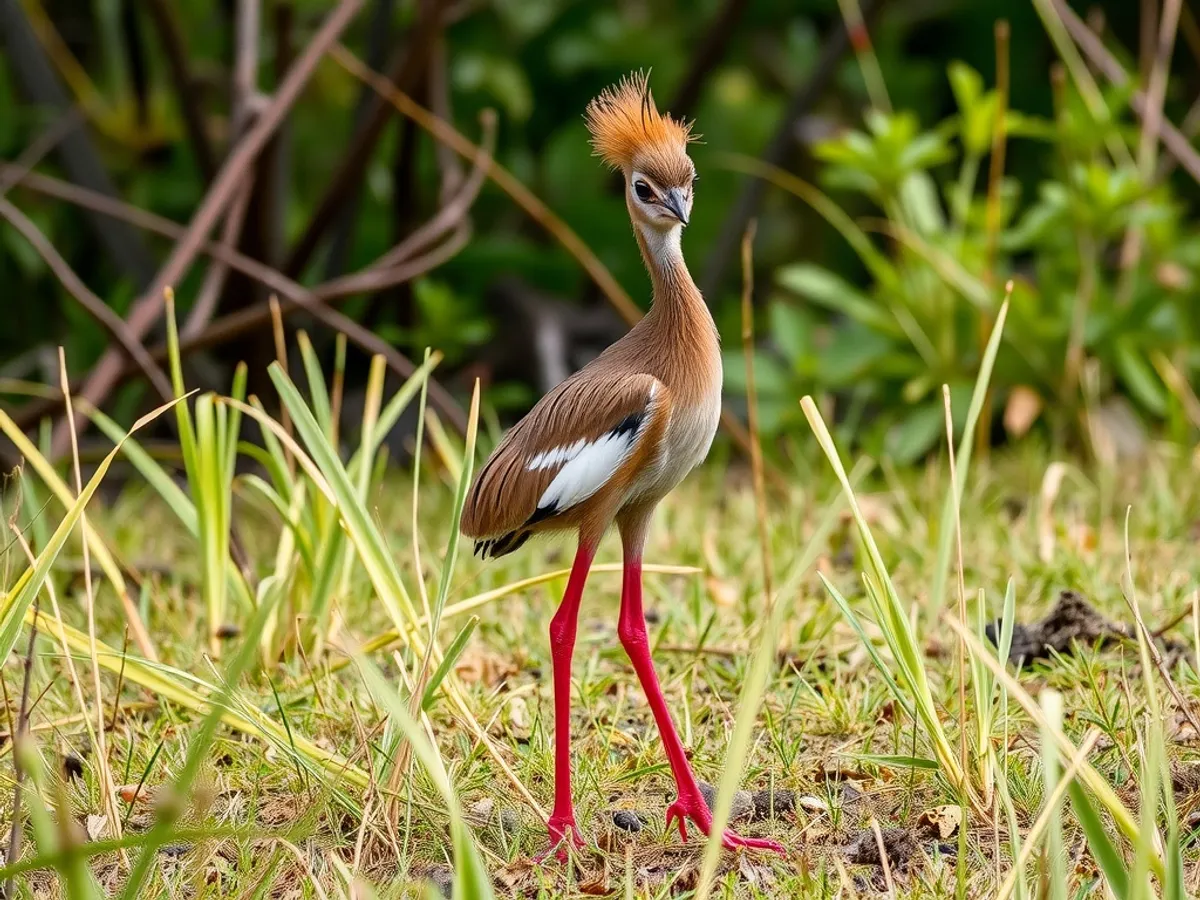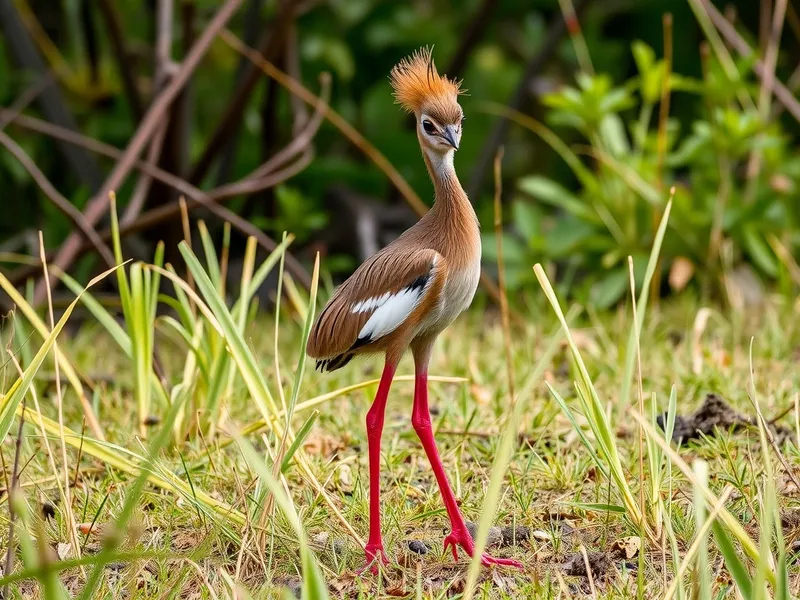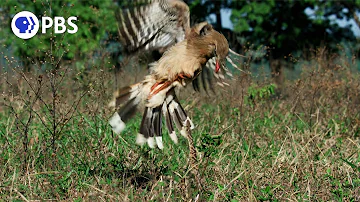
Red-legged Seriema
Cariama cristata

Meet the Red-legged Seriema
The Red-legged Seriema is a large, terrestrial bird native to South America, easily recognized by its long red legs, upright stance, and distinctive crest of feathers above its beak. It prefers open grasslands and savannas, where it hunts for insects, small mammals, reptiles, and occasionally plant matter. Capable of running at high speeds, the seriema rarely flies, instead using its strong legs to chase down prey and escape danger. Its loud, far-carrying calls are a hallmark of the Brazilian cerrado, echoing across the landscape during the early morning hours.
Classification
Bird
Habitat
Grasslands and savannas
Diet
Omnivore
Lifespan
15-20 years
Conservation
Least Concern
Weight
1.2–1.5 kg
📖Fascinating Facts
Distinctive Crest
The Red-legged Seriema has a striking crest of bristly feathers above its beak, giving it a unique appearance among birds of the savanna.
Terrestrial Hunter
This species specializes in hunting on foot, often chasing down prey such as insects, lizards, and even small snakes in the grass.
Loud Calls
Their powerful, melodious calls are used to mark territory and communicate, and they can be heard across vast distances in the early morning.
📋Detailed Description
The Red-legged Seriema (Cariama cristata) is a striking terrestrial bird measuring 90–100 cm (35–39 in) in length and weighing approximately 1.5–2 kg (3.3–4.4 lbs). It is characterized by long, robust red legs adapted for running, a slender neck, and a prominent erectile crest of bristly feathers above its short, hooked beak. Its plumage is predominantly pale brown to grayish, with subtle barring that provides camouflage in grassy habitats. The face is adorned with blue skin around the eyes and a reddish-orange beak. The wings are relatively short and rounded, reflecting its primarily terrestrial lifestyle; flight is rare and typically limited to short bursts to escape predators or reach low perches. The seriema’s tail is long and graduated, aiding in balance during rapid terrestrial movement. Its toes are equipped with sharp claws, particularly the inner toe, which is used to strike and kill prey. The species is well adapted to open environments, favoring grasslands, savannas, and the Brazilian cerrado, but can also be found in lightly wooded areas and agricultural lands. Its loud, yelping vocalizations are a distinctive feature, often delivered in duets or choruses at dawn and dusk, serving both territorial and social functions. The Red-legged Seriema is diurnal, spending most of the day foraging on foot and roosting in trees or on elevated structures at night.
💡 Did you know?
Despite their size and wings, Red-legged Seriemas are reluctant fliers and prefer to escape threats by running rapidly instead of taking flight.
🔬Research & Sources
Wikipedia Summary
The red-legged seriema, also known as the crested cariama and crested seriema, is a mostly predatory terrestrial bird in the seriema family (Cariamidae), included in the Gruiformes in the old polyphyletic circumscription but recently placed in a distinct order: Cariamiformes.
Last Modified: 10/15/2024
🎭Behavior & Social Structure
Red-legged Seriemas are predominantly solitary or found in pairs, though small family groups may occur outside the breeding season. They are highly territorial, with pairs defending large home ranges through vocal displays and visual posturing. Foraging is primarily terrestrial; the bird walks with deliberate strides, searching for prey such as insects, spiders, lizards, snakes, small mammals, and occasionally bird eggs or nestlings. They are known for their unique prey-handling behavior: after capturing larger prey, such as snakes, the seriema will repeatedly strike it against the ground or a hard surface to kill or immobilize it before swallowing. Plant matter, including fruits, seeds, and roots, supplements their diet, especially during the dry season when animal prey is less abundant. Seriemas are alert and wary, using their elevated posture and keen eyesight to scan for predators. Daily routines include periods of sunning, preening, and dust-bathing, which help maintain feather condition and control parasites.
👶Reproduction & Life Cycle
The breeding season of the Red-legged Seriema varies geographically but generally coincides with the onset of the rainy season (September to March in much of Brazil). Courtship involves mutual preening, synchronized calling, and ritualized displays where the crest is erected and wings are spread. Nests are constructed by both sexes, typically in low trees, shrubs, or occasionally on the ground, using sticks, grasses, and leaves. The female usually lays 2 pale, blotched eggs per clutch. Incubation lasts 24–30 days and is shared by both parents. Chicks are precocial, covered in down and able to leave the nest within a few days, but remain dependent on parental care for several weeks. Both parents feed and protect the young, teaching them to hunt and recognize threats. Fledging occurs at around 2–3 weeks, but juveniles may stay with the parents for several months.
🛡️Adaptations & Survival
The Red-legged Seriema exhibits several adaptations for terrestrial predation and survival in open habitats. Its long, muscular legs enable rapid running (up to 25 km/h or 15 mph), facilitating both pursuit of prey and escape from predators. The inner toe is equipped with a sharp, sickle-like claw used to subdue and dismember prey. Camouflaged plumage helps avoid detection by both prey and predators. The erectile crest and bright facial skin are used in social signaling and mate attraction. Vocalizations are adapted for long-distance communication in open landscapes, with calls audible up to 1–2 km. Behavioral flexibility allows the species to exploit a variety of food sources and habitats, including modified agricultural areas. Roosting in trees at night reduces predation risk from terrestrial mammals.
📚Research Sources
🎨Cultural Significance
The Red-legged Seriema holds a prominent place in Brazilian folklore and rural culture, often regarded as a symbol of the cerrado. Its distinctive calls are associated with the dawn and are sometimes believed to herald rain or changes in weather. In some regions, seriemas are kept as natural pest controllers, as they help reduce populations of snakes and rodents. They occasionally appear in indigenous myths and local legends, sometimes depicted as clever or vigilant guardians of the grasslands. The bird’s image is used in regional emblems and ecotourism promotion, reflecting its status as an iconic species of South American savannas.
🔬Recent Research & Discoveries
Recent research has focused on the phylogenetic placement of seriemas, confirming their status as the only extant representatives of the order Cariamiformes, a lineage with deep evolutionary roots dating back to the Paleogene. Molecular studies have clarified their relationship to other 'core landbirds,' with seriemas being more closely related to falcons and parrots than to cranes or rails, as previously thought. Behavioral ecology studies have examined their role as mesopredators in grassland ecosystems, highlighting their impact on controlling populations of small vertebrates and invertebrates. Ongoing research addresses their adaptability to habitat modification and the effects of agricultural practices on their foraging and breeding success. Vocalization studies have revealed complex duet and chorus structures, suggesting advanced social communication. Conservation genetics projects are underway to assess population structure and gene flow across fragmented landscapes.
🎥Wildlife Videos

🦩 The Red-Legged Seriema – The Stunning "Bird of Prey" With a Twist! 😲🔥
The Red-Legged Seriema – The Stunning "Bird of Prey" With a Twist! Meet the Red-Legged Seriema, a powerful and striking ...
Ases World

Raptor vs. Deadly Snake
When hunting a snake, one wrong move could be this red-legged seriema's last. Please LIKE and SUBSCRIBE if you enjoyed it!
Nature on PBS

Red legged seriema bird (Cariama cristata) kills a snake
Red legged seriema bird (Cariama cristata) kills a snake Red-legged Seriemas feed on a variety of small animals including ...
Video Collection and Gaming

Fun facts about Red-legged seriema #shorts #nature
Fun facts about Red-legged seriema #shorts #nature.
Natural Videos

LEGENDS OF THE RED DUST | Tsavo’s Predators Unleashed #naturedocumentaries | Wild Nature
LEGENDS OF THE RED DUST | Tsavo's Predators Unleashed #naturedocumentaries | Wild Nature Welcome to a wild and ...
WILD NATURE - Nature animal documentary

Introducing Inspiration: Red-Legged Seriema
Learn more about the Red-Legged Seriema, one of our newest resident birds here at Carolina Raptor Center! Follow link below to ...
Carolina Raptor Center
🌍Habitat Information
The Red-legged Seriema typically inhabits Grasslands and savannas environments. Red-legged Seriemas have adapted to their environments with specialized features and behaviors.
Primary Habitat:
Grasslands and savannas
More detailed habitat information will be available soon.
🛡️Conservation Status
The Red-legged Seriema is currently classified as Least Concern. Conservation efforts are crucial for preserving this species for future generations.
Common Threats:
- 🏠Habitat loss and fragmentation
- 🌡️Climate change impacts
- 🎯Hunting and poaching
- 🏭Human-wildlife conflict
⚠️Threats & Conservation Challenges
Currently assessed as Least Concern by the IUCN, the Red-legged Seriema remains widespread and locally common throughout much of its range in central and eastern South America. However, habitat loss due to agricultural expansion, burning, and overgrazing poses localized threats, particularly in the cerrado and pampas regions. Direct persecution is rare, as the species is not typically hunted for food or sport, but it may be affected by pesticide use and road mortality. Fragmentation of habitat can lead to reduced genetic diversity and increased vulnerability to local extinction. Despite these challenges, the species has shown adaptability to human-altered landscapes, including pastures and croplands. Ongoing monitoring is needed to detect future declines, especially as the cerrado biome faces accelerating conversion.
🔬Scientific Classification
Scientific Name
Cariama cristata
Classification Hierarchy
🔍 About Taxonomic Classification
Taxonomic classification is a hierarchical system used by scientists to classify and organize living organisms based on shared characteristics and evolutionary relationships.
The system moves from broad categories (Kingdom) to increasingly specific ones, with each animal's scientific name typically consisting of its Genus and species.
📝Community Notes
Share your observations and insights about the Red-legged Seriema with our community of wildlife enthusiasts.
Join Our Community
Sign in to share your observations and connect with fellow wildlife enthusiasts.
Sign In to ContributeNo community notes yet
Be the first to share your observations about the Red-legged Seriema!
Explore Red-legged Seriema
Select a tab above to learn more about this amazing animal.
📸Photo Gallery
No photos available for this animal yet.
🌟Discover More Wildlife
Continue your journey of discovery with more fascinating animals from our database
